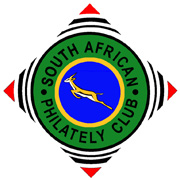Farming in SA - Wine, Sheep and the Veld.
Quote from Steve on June 25, 2025, 11:04 amThe VOC (Dutch East India Company) started a replenishment station at the Cape in 1652 in order to supply its fleets with fresh food in order to combat the high death rate from scurvy on the long voyage from Holland to SE Asia and back again. The plan was not to start a colony but to trade goods for livestock with the indigenous people, the Peninsula Khoi. As the leading trading company worldwide the VOC believed they offered the Khoi a win-win deal. Unfortunately, the Khoi were hostile to the take-over of Table Bay by the Dutch . Having all the scrap metal they needed and valuing their wealth in cattle more, these Stone Age people eventually chose to not trade with the Dutch nor work for them to develop the land which, the Khoi argued, was theirs by right of first occupation.
Whatever the rights and wrongs, the Dutch freed some of their indentured Company servants and granted them land to farm along the Liesbeeck River. The rest is colonial history! This thread looks loosely at how the Boer (Afr. farmer) culture developed.
I am not going to go into what happened in any detail, suffice to say that the Khoi attacked the Dutch, war ensued (in which very few were killed) and land was ceded. Over the years the Khoi people lost their land and cattle and then finally succumbed to European diseases, most devastatingly during the smallpox epidemic of 1713. This removed all obstacles to the Dutch, now known as 'Boers' (Afr. farmers) to 'trek' (Afr. pull) with ox-wagons into the once Khoi-owned interior. The Boer culture was based on farming, raising a large family in which the eldest son inherited the farm and the other boys, usually several, trekked on in search of their own farm and family. It was to be the Boer way of life over many generations, a model that only worked while land was available for occupation. Eventually when there was no more 'free' land, African land would be seized (Natives' Land Act of 1913) and German SWA invaded in 1914.
Returning to the impromptu Dutch colony's gradual eastward spread it had by 1754 strteched as far as today's Port Elizabeth. A feature of the colony's spread is that the trek Boers were always ahead of the VOC administration which was literally left behind. This created certain character traits among the trekkers - independence, self-reliance within a collective spirit of community and a republican ethos to rule and defend themselves. At this time the European colonists numbered some eight to 10,000. The economic model of the time was slavery. In the area of the Western Cape the Dutch, most especially those on the large established agricultural estates, possessed slaves. By 1798 it is estimated that there were some 10% more slaves than European settlers, some 26,000 slaves to 20,000 settlers. When the British occupied the Cape for the second time in 1806 slaves comprised approximately 55% of Cape Town's metropolitan population. This suggests that pretty much everyone who wasn't a European was a slave, a freed ex-slave or an indentured servant.
The initial expansion of Boers into the interior saw the Swartland and Caledon-Bredasdorp areas became important wheatlands, yielding enough to make the crop a valuable export commodity. At the same time the Cape's wine industry began to achieve a reputation overseas for quality. As the Boers expanded further sheep farming and wool became a valuable addition to the Cape's scant revenues. The financing of the Dutch colony was a huge problem for the VOC which had was already in terminal decline. Financially, the Bottom Line was that the colony was not self-sufficient. It was a drain on dwindling VOC resources at a time when costs were being cut. When the Boers ran into the Xhosa in the Eastern Cape in 1779, the ensuing struggle centred on grazing rights for cattle. With the VOC unable to protect the frontier Boers, republican sentiment developed, something that would continue under the British. Curiously, as a nation of 'farmers', the trek Boers chief source of wealth was cattle. As the Dutch never imported cattle on any scale the vast herds of indigenous Afrikener cattle that the Boers possessed had either been purchased, stolen or seized as the spoils of war from the Khoi.
My grandmother was Nel from Calvinia. Her 'stamvader' (Afr. tribe father) was the Huguenot Guillame Nel, originally of Rouen, France. He was encouraged to migrate to the Cape in 1682 with the promise of land. He became a successful farmer owning slaves and the vineyard Blaauwklippen near Somerset West. From there his descendants trekked to Swellendam, the furthest outpost of VOC authority and known as "The Gateway to the Frontier". Over generations the Nels moved around the Cape - to Graaf Reinet, Barrydale, Tarkastad, Hopetown and finally, and unusually, they turned south-west to raise sheep on a farm called Vanrhynshoek within the Hantam mountains on the outskirts of what would become Calvinia. Family legend has it that at the start of the 20th Century Vanrhynshoek was the largest sheep farm in the Cape until it was split among three Nel brothers, one of whom sold his inheritance to the dismay of the family.
The above early history of the Afrikaans side of my family is captured in Charles Bell's design of the first Cape Rectangular postage stamp of 1864 - 1877. This shows Hope seated on an anchor that signifies chandlery, the Cape's relationship with the sea and the ships that sail in it and around the southernmost tip of Africa. On either side of Hope are a vine and a ram. These were the significant industries in the Cape by the mid-19th century. (Curiously, Bell did not include wheat in his design.) The discovery of diamonds in 1866, just two years after Bell's design, would reset the Cape's economic fortunes. Diamonds would set SA on the road to its Mineral Revolution, one that would transform the country through the development of an epoch-changing industrial economy in which cattle and farming became of secondary importance to capital and mining, especially after the discovery of gold in the mid-1880s.
It is said by some with a polical assegaai to sharpen that the Boers trekked into the interior because the British had abolished slavery. Those who make this false suggestion want you to believe that all the Boers owned slaves. The fact is that all Europeans with money could buy slaves but not all did. Trek Boers were entitled to buy slaves if they could afford them but most could not. Their major investment was in a wagon, oxen, horses, guns and tools. If they were lucky they might be given or inherit a slave. Of the slaves at the Cape the bulk were found on some 60+ wealthy Western Cape estates. When the slaves were emancipated in 1834 by the British most Boers with the exception of the rich slave-owners were too poor to afford to travel to London to receive compensation for the abolition of Cape slavery. Compensation was only paid in London, nowhere else. Most colonial slave-owners were British domiciles with financial interests in the plantations of the West Indies and Caribbean and no difficulty travelling to London where many lived. The Cape Boers believed that the requirement that they must travel to London to receive compensation for their emancipated slaves was a devious British trick to cheat them out of money owed to them. Many Boers decided to trek and take their chances in the interior far from British law because they thought the British at the Cape unsympathetic and untrustworthy colonial masters, among many other issues.
1938. Voortrekker Centenary Cover shows Boers (farmers) trekking across the Drakensberg mountains into Natal.
Voortrekker Memorial Fund Stamps. Full Set. Scarce RETIEFKLIP postmark. (Only 1080 covers so cancelled.)
Piet Retief and his party of 100 were treacherously executed by the Zulu King Dingaan.
The reverse of the cover is machine cancelled BLOEDRIVIER MONUMENT.
The Boers took their revenge at the Battle of Blood River in December 1838.The chief reason the Boers' Great Trek of 1834 was to find available farmland. All the best land had already being occupied in the Western and Eastern Cape. The Eastern Cape had become 'overpopulated' due to a generation-long back-up as ther Boer's halted their eastern migration. When reports from hunters filtered in of a depopulated arable land to the north-west across the Orange River many Boers decided to trek. Most took their 'servants with them. These were mixed-race people or Khoi whose livelihood depended on the generosity of the Boers who allowed them to live on the margins of their farms in exchange for working in animal husbandry and cattle herding, as a well as transport and hunting. It was not an ideal relationship for people descended from the once proud and free Khoi now impoverished in their own, lost land. As servants they were free to leave and go but where? The British did not want them wandering around the countryside and introiduced a 'Pass' system. Most stayed to work for scraps and food.
“The Zulus Attacking The Boers during The Weenen Massacre in 1838. "
Painting by Charles Bell 1840. (The same man who designed the first Cape stamps!)
After granting the Boers land to farm in Natal, Zulu King Dingaan murdered them.
At the same time his Zulu impis launched a co-ordinated attack on Boer camps along the Bloukrans.
Fighting loyally with their 'masters' - did they have a choice? - are the Boer's 'servants'.
SA history might have taken a different road had the Zulus not embarked on treachery.
The VOC (Dutch East India Company) started a replenishment station at the Cape in 1652 in order to supply its fleets with fresh food in order to combat the high death rate from scurvy on the long voyage from Holland to SE Asia and back again. The plan was not to start a colony but to trade goods for livestock with the indigenous people, the Peninsula Khoi. As the leading trading company worldwide the VOC believed they offered the Khoi a win-win deal. Unfortunately, the Khoi were hostile to the take-over of Table Bay by the Dutch . Having all the scrap metal they needed and valuing their wealth in cattle more, these Stone Age people eventually chose to not trade with the Dutch nor work for them to develop the land which, the Khoi argued, was theirs by right of first occupation.
Whatever the rights and wrongs, the Dutch freed some of their indentured Company servants and granted them land to farm along the Liesbeeck River. The rest is colonial history! This thread looks loosely at how the Boer (Afr. farmer) culture developed.
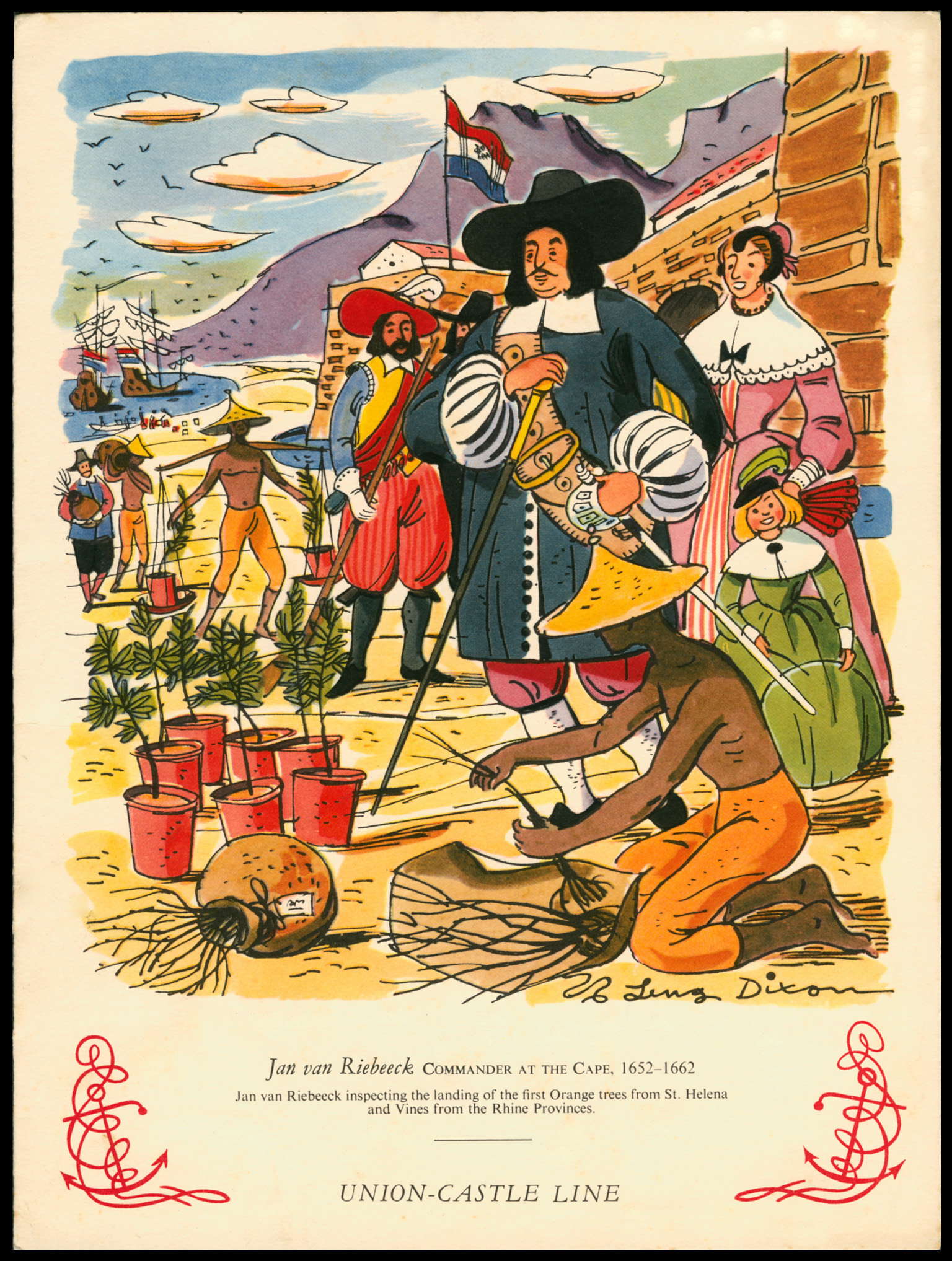
I am not going to go into what happened in any detail, suffice to say that the Khoi attacked the Dutch, war ensued (in which very few were killed) and land was ceded. Over the years the Khoi people lost their land and cattle and then finally succumbed to European diseases, most devastatingly during the smallpox epidemic of 1713. This removed all obstacles to the Dutch, now known as 'Boers' (Afr. farmers) to 'trek' (Afr. pull) with ox-wagons into the once Khoi-owned interior. The Boer culture was based on farming, raising a large family in which the eldest son inherited the farm and the other boys, usually several, trekked on in search of their own farm and family. It was to be the Boer way of life over many generations, a model that only worked while land was available for occupation. Eventually when there was no more 'free' land, African land would be seized (Natives' Land Act of 1913) and German SWA invaded in 1914.
Returning to the impromptu Dutch colony's gradual eastward spread it had by 1754 strteched as far as today's Port Elizabeth. A feature of the colony's spread is that the trek Boers were always ahead of the VOC administration which was literally left behind. This created certain character traits among the trekkers - independence, self-reliance within a collective spirit of community and a republican ethos to rule and defend themselves. At this time the European colonists numbered some eight to 10,000. The economic model of the time was slavery. In the area of the Western Cape the Dutch, most especially those on the large established agricultural estates, possessed slaves. By 1798 it is estimated that there were some 10% more slaves than European settlers, some 26,000 slaves to 20,000 settlers. When the British occupied the Cape for the second time in 1806 slaves comprised approximately 55% of Cape Town's metropolitan population. This suggests that pretty much everyone who wasn't a European was a slave, a freed ex-slave or an indentured servant.
The initial expansion of Boers into the interior saw the Swartland and Caledon-Bredasdorp areas became important wheatlands, yielding enough to make the crop a valuable export commodity. At the same time the Cape's wine industry began to achieve a reputation overseas for quality. As the Boers expanded further sheep farming and wool became a valuable addition to the Cape's scant revenues. The financing of the Dutch colony was a huge problem for the VOC which had was already in terminal decline. Financially, the Bottom Line was that the colony was not self-sufficient. It was a drain on dwindling VOC resources at a time when costs were being cut. When the Boers ran into the Xhosa in the Eastern Cape in 1779, the ensuing struggle centred on grazing rights for cattle. With the VOC unable to protect the frontier Boers, republican sentiment developed, something that would continue under the British. Curiously, as a nation of 'farmers', the trek Boers chief source of wealth was cattle. As the Dutch never imported cattle on any scale the vast herds of indigenous Afrikener cattle that the Boers possessed had either been purchased, stolen or seized as the spoils of war from the Khoi.
My grandmother was Nel from Calvinia. Her 'stamvader' (Afr. tribe father) was the Huguenot Guillame Nel, originally of Rouen, France. He was encouraged to migrate to the Cape in 1682 with the promise of land. He became a successful farmer owning slaves and the vineyard Blaauwklippen near Somerset West. From there his descendants trekked to Swellendam, the furthest outpost of VOC authority and known as "The Gateway to the Frontier". Over generations the Nels moved around the Cape - to Graaf Reinet, Barrydale, Tarkastad, Hopetown and finally, and unusually, they turned south-west to raise sheep on a farm called Vanrhynshoek within the Hantam mountains on the outskirts of what would become Calvinia. Family legend has it that at the start of the 20th Century Vanrhynshoek was the largest sheep farm in the Cape until it was split among three Nel brothers, one of whom sold his inheritance to the dismay of the family.
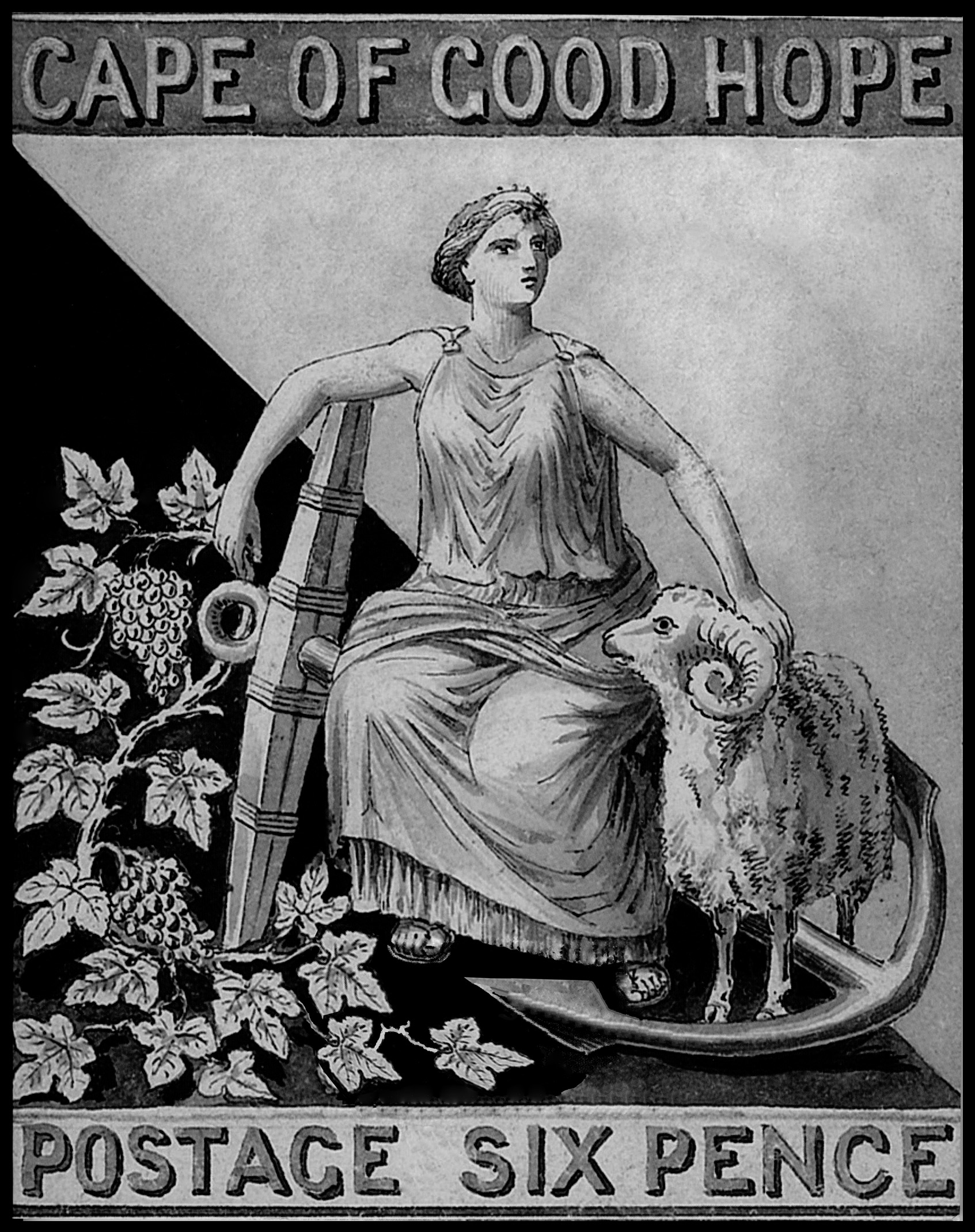
The above early history of the Afrikaans side of my family is captured in Charles Bell's design of the first Cape Rectangular postage stamp of 1864 - 1877. This shows Hope seated on an anchor that signifies chandlery, the Cape's relationship with the sea and the ships that sail in it and around the southernmost tip of Africa. On either side of Hope are a vine and a ram. These were the significant industries in the Cape by the mid-19th century. (Curiously, Bell did not include wheat in his design.) The discovery of diamonds in 1866, just two years after Bell's design, would reset the Cape's economic fortunes. Diamonds would set SA on the road to its Mineral Revolution, one that would transform the country through the development of an epoch-changing industrial economy in which cattle and farming became of secondary importance to capital and mining, especially after the discovery of gold in the mid-1880s.
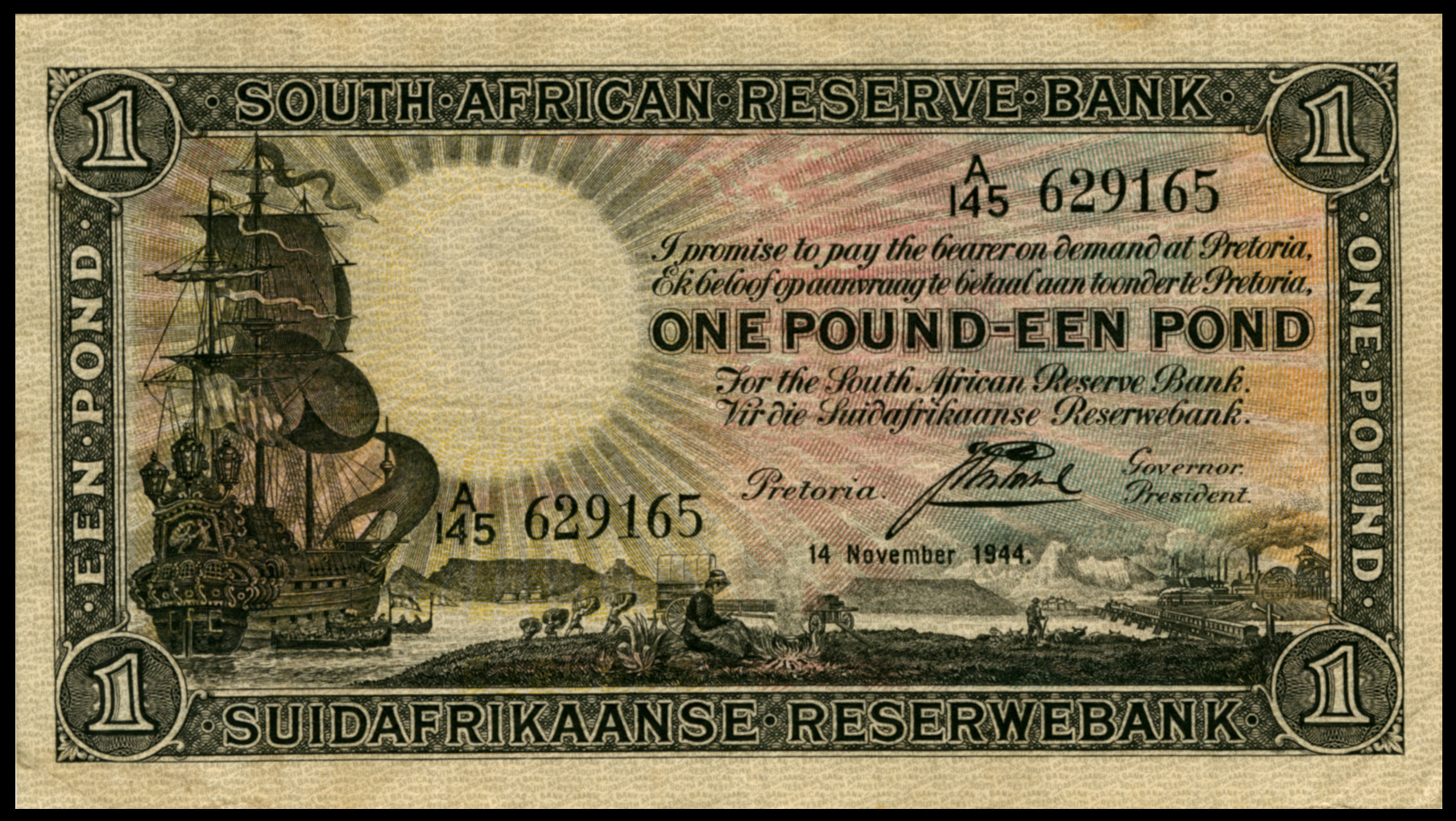
It is said by some with a polical assegaai to sharpen that the Boers trekked into the interior because the British had abolished slavery. Those who make this false suggestion want you to believe that all the Boers owned slaves. The fact is that all Europeans with money could buy slaves but not all did. Trek Boers were entitled to buy slaves if they could afford them but most could not. Their major investment was in a wagon, oxen, horses, guns and tools. If they were lucky they might be given or inherit a slave. Of the slaves at the Cape the bulk were found on some 60+ wealthy Western Cape estates. When the slaves were emancipated in 1834 by the British most Boers with the exception of the rich slave-owners were too poor to afford to travel to London to receive compensation for the abolition of Cape slavery. Compensation was only paid in London, nowhere else. Most colonial slave-owners were British domiciles with financial interests in the plantations of the West Indies and Caribbean and no difficulty travelling to London where many lived. The Cape Boers believed that the requirement that they must travel to London to receive compensation for their emancipated slaves was a devious British trick to cheat them out of money owed to them. Many Boers decided to trek and take their chances in the interior far from British law because they thought the British at the Cape unsympathetic and untrustworthy colonial masters, among many other issues.
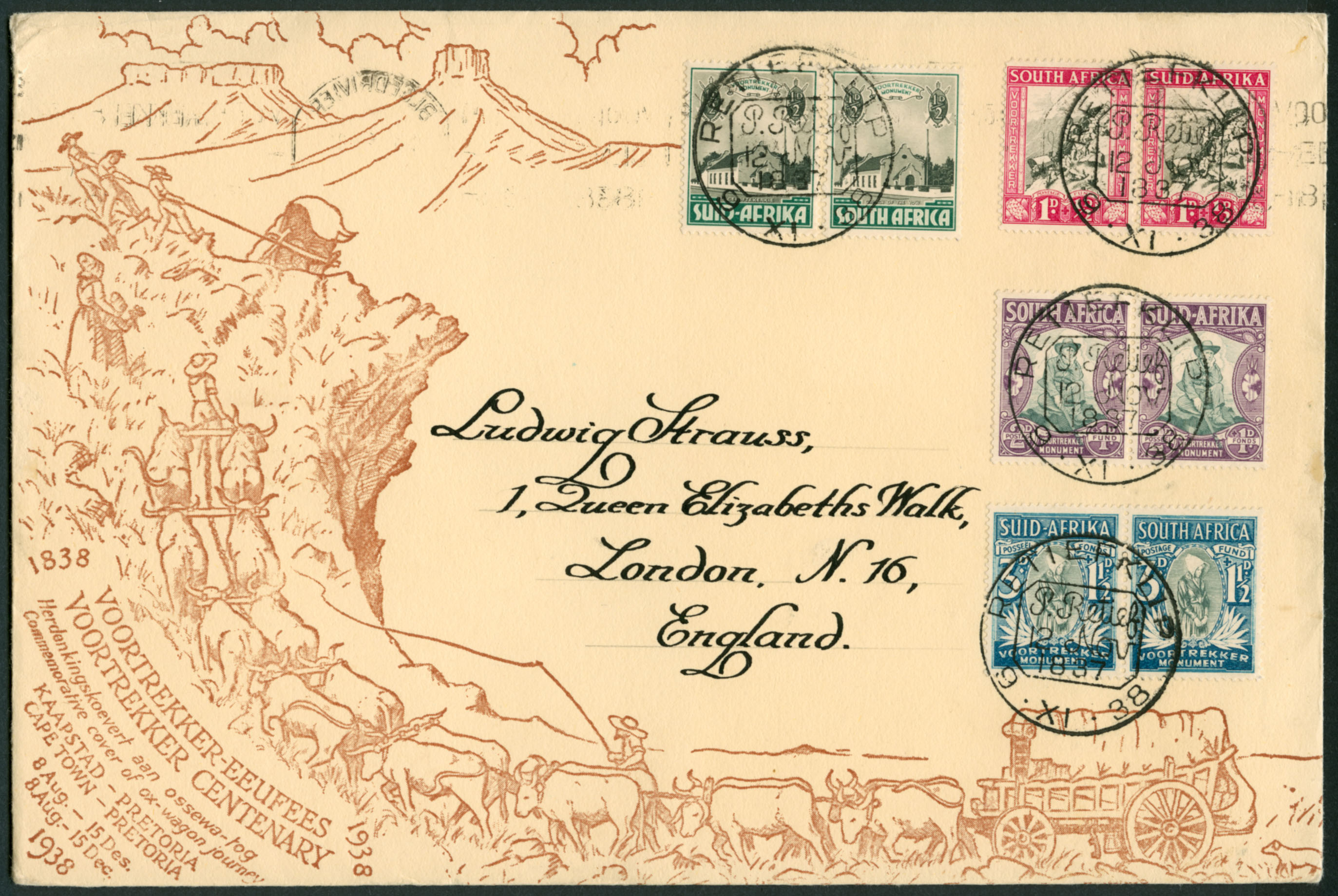
1938. Voortrekker Centenary Cover shows Boers (farmers) trekking across the Drakensberg mountains into Natal.
Voortrekker Memorial Fund Stamps. Full Set. Scarce RETIEFKLIP postmark. (Only 1080 covers so cancelled.)
Piet Retief and his party of 100 were treacherously executed by the Zulu King Dingaan.
The reverse of the cover is machine cancelled BLOEDRIVIER MONUMENT.
The Boers took their revenge at the Battle of Blood River in December 1838.
The chief reason the Boers' Great Trek of 1834 was to find available farmland. All the best land had already being occupied in the Western and Eastern Cape. The Eastern Cape had become 'overpopulated' due to a generation-long back-up as ther Boer's halted their eastern migration. When reports from hunters filtered in of a depopulated arable land to the north-west across the Orange River many Boers decided to trek. Most took their 'servants with them. These were mixed-race people or Khoi whose livelihood depended on the generosity of the Boers who allowed them to live on the margins of their farms in exchange for working in animal husbandry and cattle herding, as a well as transport and hunting. It was not an ideal relationship for people descended from the once proud and free Khoi now impoverished in their own, lost land. As servants they were free to leave and go but where? The British did not want them wandering around the countryside and introiduced a 'Pass' system. Most stayed to work for scraps and food.
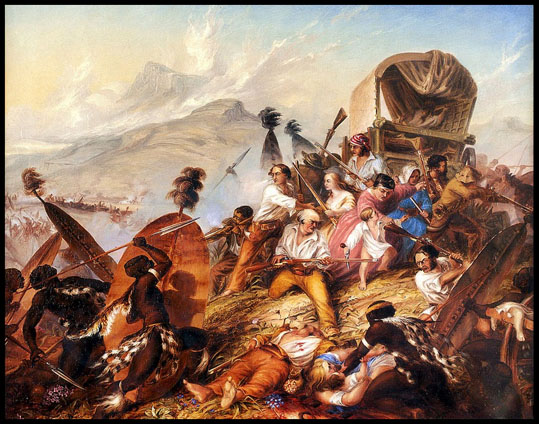
“The Zulus Attacking The Boers during The Weenen Massacre in 1838. "
Painting by Charles Bell 1840. (The same man who designed the first Cape stamps!)
After granting the Boers land to farm in Natal, Zulu King Dingaan murdered them.
At the same time his Zulu impis launched a co-ordinated attack on Boer camps along the Bloukrans.
Fighting loyally with their 'masters' - did they have a choice? - are the Boer's 'servants'.
SA history might have taken a different road had the Zulus not embarked on treachery.
Quote from Steve on June 25, 2025, 11:44 amWine - Groot Constantia
South African winemaking began with the arrival of the Dutch East India Company (VOC) in 1652 under the command of Jan van Riebeeck. The primary purpose was for the Cape to act as a replenishment station providing fresh food to Dutch ships traveling between Europe and the East Indies. Van Riebeeck planted the first vineyard in 1655 and by 1659 had produced the first wine made in SA.
1907. Postcard. CAPE TOWN '11 DEC 1907' to GB.
'Groote Constantia. Government Experimental Wine Farm. (T. D. Ravenscroft, Rondebosch.)
Given the growth of the Cape's tourist industry, Groot Constantia is the subject of many modern postcards.
This old postcard from circa 1905 is uncommon.It was Van Riebeeck’s successor, Simon van der Stel, who most significantly expanded viticulture at the Cape by his establishment of the Groot Constantia estate in 1685. Over time it would gain an international reputation for producing high-quality wines. As the Cape's economy at this time was based on slavery, hundreds of slaves would have been put to work at Groot Constantia.
It's a mighty hard road that these poor hands have hoed...
Dig the beets from your ground, cut the grapes from your vine
To set on your table your light sparkling wine.
'Pastures of Plenty' (Woody Guthrie. 1941).Groot Constantia's sucess was extended under the guidance of French Huguenots escaping religious persecution in France. There was a small but ultimately significant influx of French Huguenots into the Cape in the late 17th century. Many were skilled artisans including winemakers who settled largely in the Franschhoek Valley, (Afr. French Corner) near Paarl and Stellenbosch, both later important wine producting areas. The Huguenots introduced new grape varieties and winemaking techniques. By integrating traditional French viticultural practices with existing Dutch methods the Cape developed its own unique and robust winemaking culture.
1939. Union of SA Hyphenated Pictorial Definitive Issue.
Blue and sepia block of 4 x 10s top values postmarked JOHANNESBURG 67.Once upon a time one of the historical artefacts visitors to Groot Constantia could see was the Slave Bell which was rung to signal the start and end of a day's labour. These were a feature of every large Cape Dutch estate. Groot Constantia's 110kg brass bell dated back to 1814, a time when the Cape was under the control of the British who had ended the sale of slaves in 1807 but not slavery itself.
A Dutch-era farm using the economic model of slavery.
Eleven slaves are seen working overseen by three Cape Dutchmen.The emancipation of Cape slaves would not take place until 1834. In September 2024 the Groot Constantia Slave Bell was stolen. Two suspects were arrested in connection with the theft. The bell clapper was recovered in November 2024 but the main bell remains missing. It is possible that it was sold for its 'scrap' metal content. Was this an act of liberation by the descendant of slaves looking for justice and restitution or was it an act of survival by people marginalised by the ANC government's years of financial mismanagement and mafia socialism - stealing anything not tied down and distributing peanuts in return for loyalty?
1939. Union of SA Hyphenated Pictorial Definitive Issue.
Blue and sepia single 10s top values postmarked DURBAN '23 X 49'.The area known as Tokai that borders on Constantia is named after Tokay or Tokaji in Hungary, a region celebrated for its production of sweet wine made from grapes affected by noble rot (Botrytis cinerea). This land was granted in 1792 at the end of the VOC (Dutch East India Company) era at the Cape. (The VOC was liquidated in 1800.) Governor Johan Isaac Rhenius who started the first Dutch Post Office at the Cape in the same year granted the land to an Estonian. (His country is not known for its wine!).
There are several historic references to the wine from this area. In popular English culture Jane Austen referenced Constantia wine in her novel 'Sense and Sensibility' of 1811. In this Mrs. Jennings recommends "a little Constantia" to Marianne Dashwood as a remedy for a broken heart. (Given that Mrs Jennings is only recommending "a little Constantia", her advice is not to drink to forget -unlike some of us older folk who drink to remember!)
Therre is a long and interesting connection between slavery, the wine industry and the oppression of farm labourers. A compelling financial incentive for the large wine estates to accept emancipation was the poetntial for increased profits through low wage costs!
Wine - Groot Constantia
South African winemaking began with the arrival of the Dutch East India Company (VOC) in 1652 under the command of Jan van Riebeeck. The primary purpose was for the Cape to act as a replenishment station providing fresh food to Dutch ships traveling between Europe and the East Indies. Van Riebeeck planted the first vineyard in 1655 and by 1659 had produced the first wine made in SA.
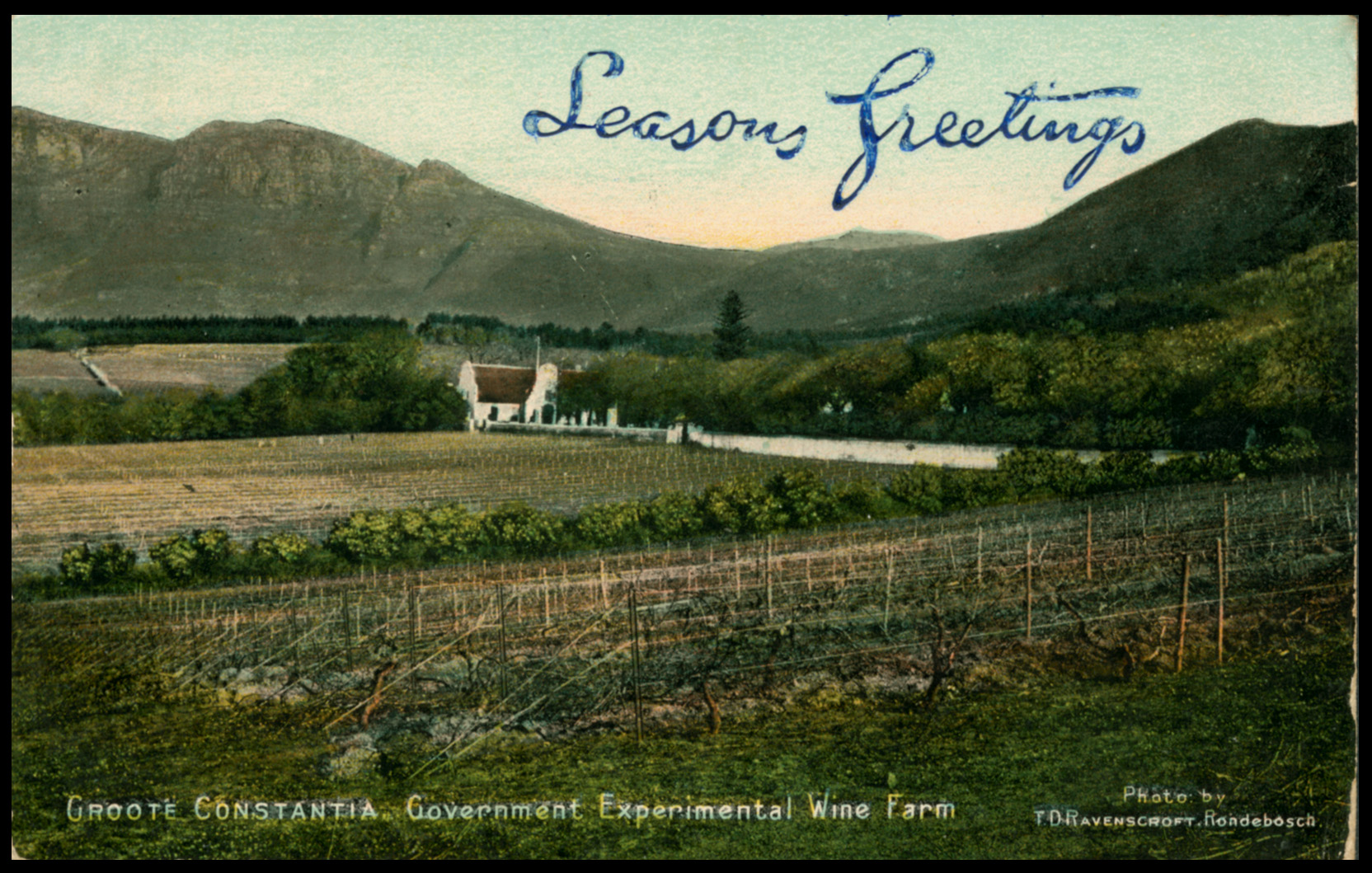
1907. Postcard. CAPE TOWN '11 DEC 1907' to GB.
'Groote Constantia. Government Experimental Wine Farm. (T. D. Ravenscroft, Rondebosch.)
Given the growth of the Cape's tourist industry, Groot Constantia is the subject of many modern postcards.
This old postcard from circa 1905 is uncommon.
It was Van Riebeeck’s successor, Simon van der Stel, who most significantly expanded viticulture at the Cape by his establishment of the Groot Constantia estate in 1685. Over time it would gain an international reputation for producing high-quality wines. As the Cape's economy at this time was based on slavery, hundreds of slaves would have been put to work at Groot Constantia.
It's a mighty hard road that these poor hands have hoed...
Dig the beets from your ground, cut the grapes from your vine
To set on your table your light sparkling wine.
'Pastures of Plenty' (Woody Guthrie. 1941).
Groot Constantia's sucess was extended under the guidance of French Huguenots escaping religious persecution in France. There was a small but ultimately significant influx of French Huguenots into the Cape in the late 17th century. Many were skilled artisans including winemakers who settled largely in the Franschhoek Valley, (Afr. French Corner) near Paarl and Stellenbosch, both later important wine producting areas. The Huguenots introduced new grape varieties and winemaking techniques. By integrating traditional French viticultural practices with existing Dutch methods the Cape developed its own unique and robust winemaking culture.
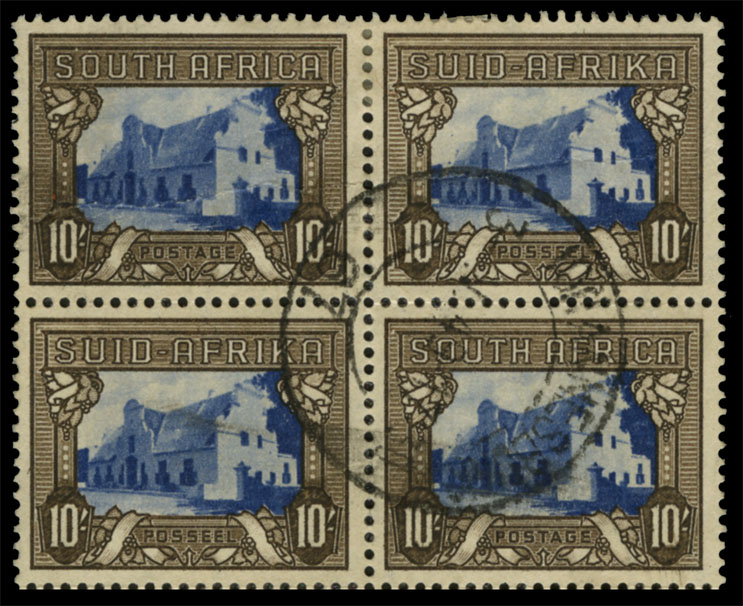
1939. Union of SA Hyphenated Pictorial Definitive Issue.
Blue and sepia block of 4 x 10s top values postmarked JOHANNESBURG 67.
Once upon a time one of the historical artefacts visitors to Groot Constantia could see was the Slave Bell which was rung to signal the start and end of a day's labour. These were a feature of every large Cape Dutch estate. Groot Constantia's 110kg brass bell dated back to 1814, a time when the Cape was under the control of the British who had ended the sale of slaves in 1807 but not slavery itself.
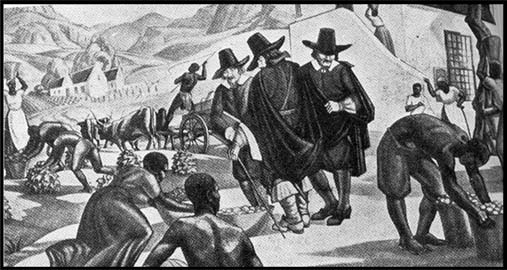
A Dutch-era farm using the economic model of slavery.
Eleven slaves are seen working overseen by three Cape Dutchmen.
The emancipation of Cape slaves would not take place until 1834. In September 2024 the Groot Constantia Slave Bell was stolen. Two suspects were arrested in connection with the theft. The bell clapper was recovered in November 2024 but the main bell remains missing. It is possible that it was sold for its 'scrap' metal content. Was this an act of liberation by the descendant of slaves looking for justice and restitution or was it an act of survival by people marginalised by the ANC government's years of financial mismanagement and mafia socialism - stealing anything not tied down and distributing peanuts in return for loyalty?
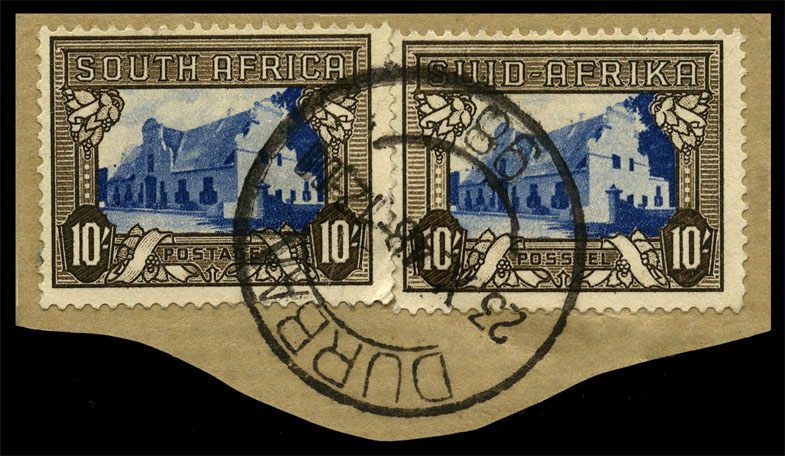
1939. Union of SA Hyphenated Pictorial Definitive Issue.
Blue and sepia single 10s top values postmarked DURBAN '23 X 49'.
The area known as Tokai that borders on Constantia is named after Tokay or Tokaji in Hungary, a region celebrated for its production of sweet wine made from grapes affected by noble rot (Botrytis cinerea). This land was granted in 1792 at the end of the VOC (Dutch East India Company) era at the Cape. (The VOC was liquidated in 1800.) Governor Johan Isaac Rhenius who started the first Dutch Post Office at the Cape in the same year granted the land to an Estonian. (His country is not known for its wine!).
There are several historic references to the wine from this area. In popular English culture Jane Austen referenced Constantia wine in her novel 'Sense and Sensibility' of 1811. In this Mrs. Jennings recommends "a little Constantia" to Marianne Dashwood as a remedy for a broken heart. (Given that Mrs Jennings is only recommending "a little Constantia", her advice is not to drink to forget -unlike some of us older folk who drink to remember!)
Therre is a long and interesting connection between slavery, the wine industry and the oppression of farm labourers. A compelling financial incentive for the large wine estates to accept emancipation was the poetntial for increased profits through low wage costs!
Quote from Steve on June 27, 2025, 1:18 pmWool - Sheep come to southern Africa
Broadly, there have been three migrations into southern Africa - the San and the Khoi, the Bantu and Europeans in that order.
It was once said that the San, (aka 'Bushmen), arrived some 100,000 years or so ago. Little trace of these hunter-gatherers remains except paintings on rocks and in caves across central and southern Africa. Today it is thought that the San and the Khoi were the same people - they shared the same language - who came from central Africa but who developed down very different routes. The San chose to be hunter-gatherers while the Khoi became pastoralists who introduced domesticated livestock - cattle, sheep and goats - to SA. They weren't farmers in the conventional sense but they did practice animal husbandry, generally regarded as a branch of agriculture.
The surprising thing about the Khoi is that they possessed sheep, an animal generally thought to have originated in the Middle East. On that slender basis some assume that the Khoi came from the Middle East. (However, traces of Khoi DNA have now been found in southern Europe.) The fact that the Khoi had sheep is not proof that they are people from the Middle East. At best, it suggests that their ancestors had been in contact with people who had fat-tailed sheep that had originally come from the Middle East.
1713. (Unknown). This is probably the best illustration of the Khoi to be found anywhere. These two sketches are from a set of 27 drawings on 15 sheets that was discovered in the National Library of South Africa in 1986. The drawings are important for presenting the earliest realistic depictions of the Khoikhoi, the original inhabitants of the Western Cape.
The drawings give details of Khoi activities and dress. The annotations, in Dutch, refer to the tobacco bag hanging on the back of the individual on the left of the left-hand sketch; to the ox-hide shoes fastened with leather thongs worn by the person shown seated in the lower right of this sketch; to the pointed cap and beads worn by the woman who is the main figure in the right-hand sketch; and to the "corn heaps" behind the seated woman on the right of this sketch. The latter is an erroneous reference to the Khoi houses depicted by the artist and is one of the many indications that the notes were not made by the artist himself but by someone else who was not as familiar with the Khoi. Much information about the Khoikhoi is available from early European accounts, but few illustrations exist. The drawings in the collection were made in situ and, unlike most early European depictions of the Khoikhoi, were never filtered through the eyes of European engravers. The artist most likely was a Dutchman, born in the 17th century, who was attached in some capacity to the Dutch East India Company and possibly en route to the Dutch East Indies or on his way back to the Netherlands when he visited the Cape. Evidence suggests that the drawings were made no later than 1713*, and possibly a good deal earlier. Most of the drawings have annotations, made by another person, also unidentified, after 1730. (US LIbrary of Congress.)
* Khoi society collapsed and never recoverd after the smallpox holocaust of 1713.Bantu people from West Africa with cattle but not sheep arrived in northern SA and Natal about 1500 years ago, long after the Khoi and San. Their arrival generally had the effect of hemming the Khoi and San into the more arid south-western section of southern Africa where they were found when Europeans arrived in 1652. The Bantu migration largely stalled in the Eastern Cape because the weather there transitioned from summer to winter rainfall. The traditional Bantu crops that they had brought with them, like sorghum, which they planted at the start of summer every year, could not be grown in southern Africa's winter rainfall regions.
This San rock art from Lesotho shows the San attempting to drive off Bantu cattle.
The small red men with bows and arrows are the San, the taller warriors the Bantu.
The Bantu and the Boers hunted and killed San caught slaughtering their cattle.
Nelson Mandela's San blood shows that the Bantu did interbreed with the San / Khoi.The Khoi's sheep were characterized by a large, fat-filled tail, a valuable source of fat for cooking and other purposes. Early European visitors to the Cape (pre-1652) went to great lengths to describe the disgusting smell of 'Hottentots' smeared in rancid fat. Besides a source of food, fat-tailed sheep were also used for clothing. The Afrikaans word 'karos' is believed to come from the Khoi. As a boy growing up in SA I had a 'karos' sheep skin. The Khoi would wear these across the shoulders and upper torso when cold. The word 'karos' can be seen used in the second landscape image.
The fat-tailed sheep had suited the Khoi's needs and they had adapted to their limitations. The Khoi's relatively small population, (by most estimates some 100,000) and the corresponding size of their flocks allowed them to live off the land in a sustainable way. This relationship changed dramatically after the arriving Europeans began to import new and better breeds of sheep for the purposes of earning revenue in the relatively high-priced European wool markets. The importation of Merino sheep and the consequent development of the wool industry in the Cape would have a devastating affect on southern Africa's veld environment which had previously sustained the greatest number of free roaming antelope species the world has ever known.
The Merino Sheep
1953 1 October. Definitive issue.
The Merino sheep were once the monopoly of the King of Spain. Because they produced a high yield of top quality wool they were jealously guarded and became a very important Spanish export in the Middle Ages. Over time the King of Spain made gifts of Merino sheep to other regents and slowly exclusive ownership of this prized animal began percolate down to others. After Spain had conquered Holland it attempted to raise Merino sheep in the Low Countries, a wet and damp environment for which it was not suited. Once the Dutch had regained their freedom they dispatched the under-performing Merino sheep to the Cape where they thrived in the drier climate. Merino sheeep were sent from the Cape to Australia in the starving early years of that penal colony's difficult founding.
By 1870 much of the Cape wase given over to Merino sheep farming.
Barbed wire fences, hunting and over-grazing would have a devastating effect on wildlife.
Wool - Sheep come to southern Africa
Broadly, there have been three migrations into southern Africa - the San and the Khoi, the Bantu and Europeans in that order.
It was once said that the San, (aka 'Bushmen), arrived some 100,000 years or so ago. Little trace of these hunter-gatherers remains except paintings on rocks and in caves across central and southern Africa. Today it is thought that the San and the Khoi were the same people - they shared the same language - who came from central Africa but who developed down very different routes. The San chose to be hunter-gatherers while the Khoi became pastoralists who introduced domesticated livestock - cattle, sheep and goats - to SA. They weren't farmers in the conventional sense but they did practice animal husbandry, generally regarded as a branch of agriculture.
The surprising thing about the Khoi is that they possessed sheep, an animal generally thought to have originated in the Middle East. On that slender basis some assume that the Khoi came from the Middle East. (However, traces of Khoi DNA have now been found in southern Europe.) The fact that the Khoi had sheep is not proof that they are people from the Middle East. At best, it suggests that their ancestors had been in contact with people who had fat-tailed sheep that had originally come from the Middle East.
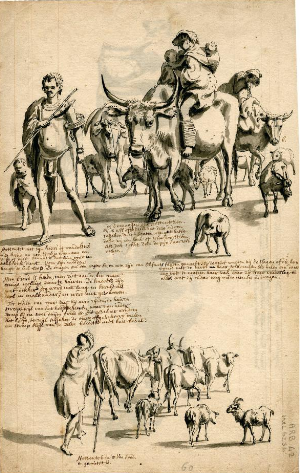
1713. (Unknown). This is probably the best illustration of the Khoi to be found anywhere. These two sketches are from a set of 27 drawings on 15 sheets that was discovered in the National Library of South Africa in 1986. The drawings are important for presenting the earliest realistic depictions of the Khoikhoi, the original inhabitants of the Western Cape.

The drawings give details of Khoi activities and dress. The annotations, in Dutch, refer to the tobacco bag hanging on the back of the individual on the left of the left-hand sketch; to the ox-hide shoes fastened with leather thongs worn by the person shown seated in the lower right of this sketch; to the pointed cap and beads worn by the woman who is the main figure in the right-hand sketch; and to the "corn heaps" behind the seated woman on the right of this sketch. The latter is an erroneous reference to the Khoi houses depicted by the artist and is one of the many indications that the notes were not made by the artist himself but by someone else who was not as familiar with the Khoi. Much information about the Khoikhoi is available from early European accounts, but few illustrations exist. The drawings in the collection were made in situ and, unlike most early European depictions of the Khoikhoi, were never filtered through the eyes of European engravers. The artist most likely was a Dutchman, born in the 17th century, who was attached in some capacity to the Dutch East India Company and possibly en route to the Dutch East Indies or on his way back to the Netherlands when he visited the Cape. Evidence suggests that the drawings were made no later than 1713*, and possibly a good deal earlier. Most of the drawings have annotations, made by another person, also unidentified, after 1730. (US LIbrary of Congress.)
* Khoi society collapsed and never recoverd after the smallpox holocaust of 1713.
Bantu people from West Africa with cattle but not sheep arrived in northern SA and Natal about 1500 years ago, long after the Khoi and San. Their arrival generally had the effect of hemming the Khoi and San into the more arid south-western section of southern Africa where they were found when Europeans arrived in 1652. The Bantu migration largely stalled in the Eastern Cape because the weather there transitioned from summer to winter rainfall. The traditional Bantu crops that they had brought with them, like sorghum, which they planted at the start of summer every year, could not be grown in southern Africa's winter rainfall regions.

This San rock art from Lesotho shows the San attempting to drive off Bantu cattle.
The small red men with bows and arrows are the San, the taller warriors the Bantu.
The Bantu and the Boers hunted and killed San caught slaughtering their cattle.
Nelson Mandela's San blood shows that the Bantu did interbreed with the San / Khoi.
The Khoi's sheep were characterized by a large, fat-filled tail, a valuable source of fat for cooking and other purposes. Early European visitors to the Cape (pre-1652) went to great lengths to describe the disgusting smell of 'Hottentots' smeared in rancid fat. Besides a source of food, fat-tailed sheep were also used for clothing. The Afrikaans word 'karos' is believed to come from the Khoi. As a boy growing up in SA I had a 'karos' sheep skin. The Khoi would wear these across the shoulders and upper torso when cold. The word 'karos' can be seen used in the second landscape image.
The fat-tailed sheep had suited the Khoi's needs and they had adapted to their limitations. The Khoi's relatively small population, (by most estimates some 100,000) and the corresponding size of their flocks allowed them to live off the land in a sustainable way. This relationship changed dramatically after the arriving Europeans began to import new and better breeds of sheep for the purposes of earning revenue in the relatively high-priced European wool markets. The importation of Merino sheep and the consequent development of the wool industry in the Cape would have a devastating affect on southern Africa's veld environment which had previously sustained the greatest number of free roaming antelope species the world has ever known.
The Merino Sheep
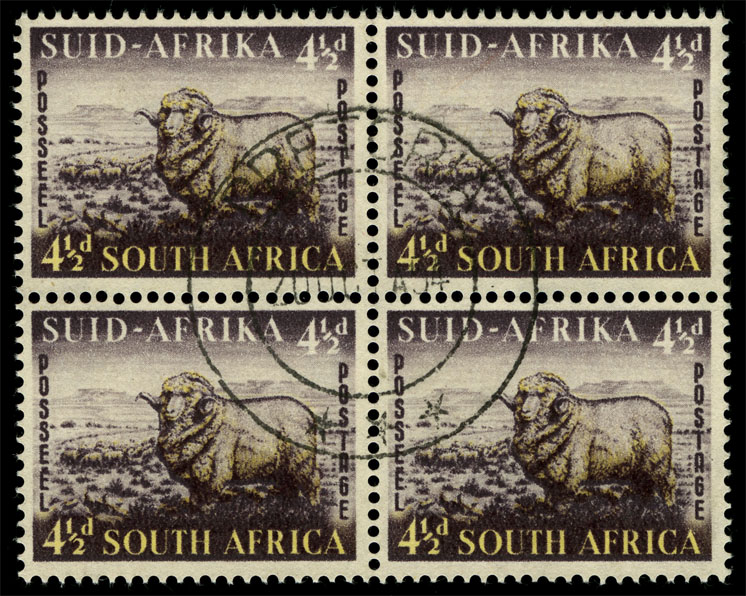
1953 1 October. Definitive issue.
The Merino sheep were once the monopoly of the King of Spain. Because they produced a high yield of top quality wool they were jealously guarded and became a very important Spanish export in the Middle Ages. Over time the King of Spain made gifts of Merino sheep to other regents and slowly exclusive ownership of this prized animal began percolate down to others. After Spain had conquered Holland it attempted to raise Merino sheep in the Low Countries, a wet and damp environment for which it was not suited. Once the Dutch had regained their freedom they dispatched the under-performing Merino sheep to the Cape where they thrived in the drier climate. Merino sheeep were sent from the Cape to Australia in the starving early years of that penal colony's difficult founding.
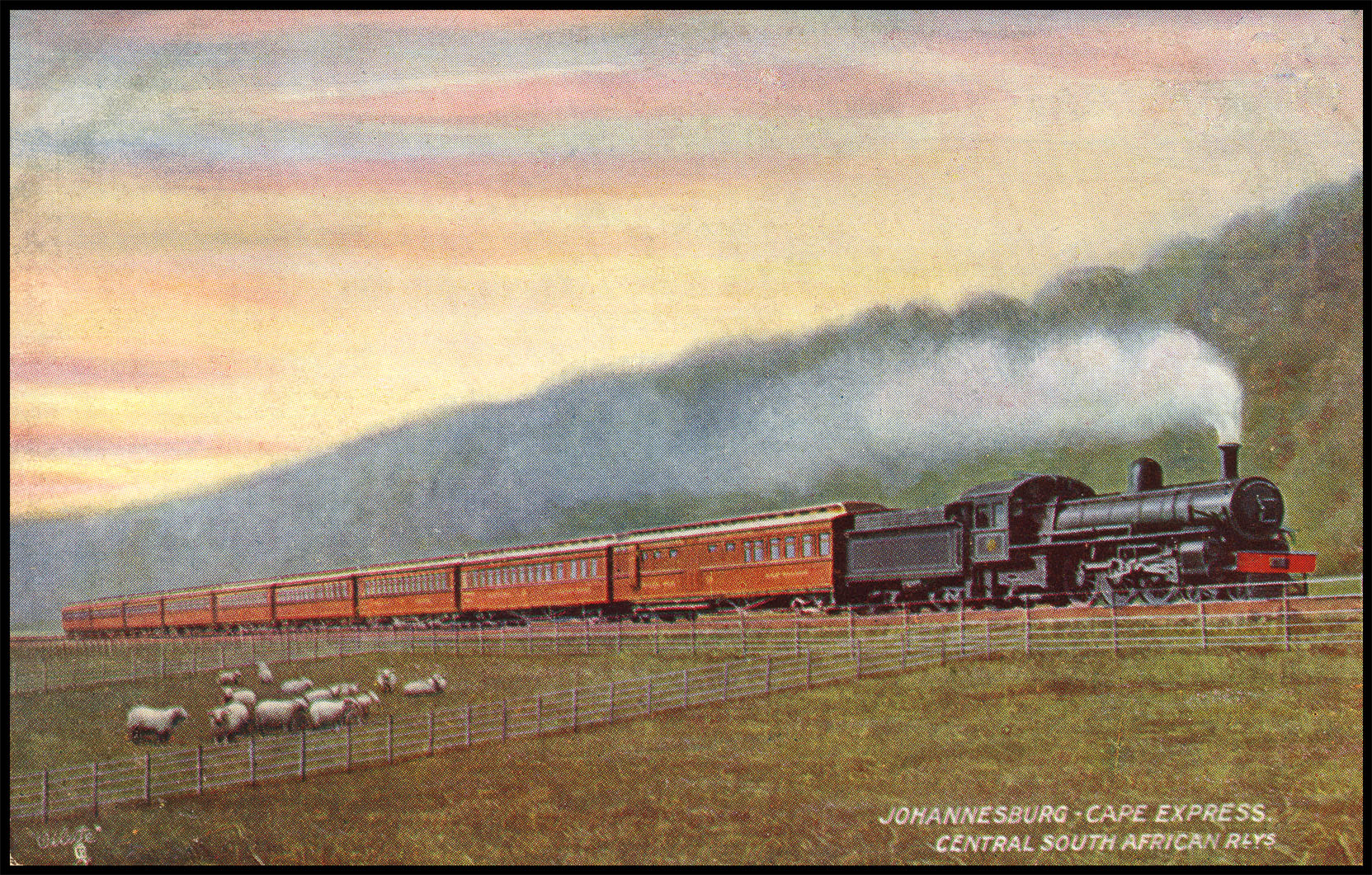
By 1870 much of the Cape wase given over to Merino sheep farming.
Barbed wire fences, hunting and over-grazing would have a devastating effect on wildlife.
Quote from Jamie Smith on June 27, 2025, 1:29 pmYou missed out the Hottentots and the Strandloopers. And, the main bantu migration met the Europeans in the Estern Cape showing that the Europeans were in the actual Cape before the Bantu had arrived. Refer to Ndaba my Children by Vusamazulu Credo Mutwa.
You missed out the Hottentots and the Strandloopers. And, the main bantu migration met the Europeans in the Estern Cape showing that the Europeans were in the actual Cape before the Bantu had arrived. Refer to Ndaba my Children by Vusamazulu Credo Mutwa.
Quote from Steve on June 27, 2025, 2:30 pmYes, I broadly agree. However, the 'Hottentots' and the Strandlopers were both names given to Khoikhoi 'clans'. You can definitely say that the Boers were first in the southern part of the Eastern Cape (if you exclude the Khoi and San) when they banged heads with the Xhosa (Bantu) in the northern part. During their migration from the Western Cape to the Eastern Cape the Boers met none except Khoi and San along the way. Being more elusive and wary the San were presumably not as badly devastated as the Khoi by European diseases. They put up one helluva fight in the Sneeuberg Mountains. the first anti-colonial war of resistnce fought in SA if not Africa. For their troubles they were made to suffer genocide. The Boers under guidance of the VOC developed their commando tactics there. Those who got there first is a red herring. It is now about how we will live together in future. My thoughts are that a better understanding of history will be a good start.
Yes, I broadly agree. However, the 'Hottentots' and the Strandlopers were both names given to Khoikhoi 'clans'. You can definitely say that the Boers were first in the southern part of the Eastern Cape (if you exclude the Khoi and San) when they banged heads with the Xhosa (Bantu) in the northern part. During their migration from the Western Cape to the Eastern Cape the Boers met none except Khoi and San along the way. Being more elusive and wary the San were presumably not as badly devastated as the Khoi by European diseases. They put up one helluva fight in the Sneeuberg Mountains. the first anti-colonial war of resistnce fought in SA if not Africa. For their troubles they were made to suffer genocide. The Boers under guidance of the VOC developed their commando tactics there. Those who got there first is a red herring. It is now about how we will live together in future. My thoughts are that a better understanding of history will be a good start.
Quote from Jamie Smith on June 28, 2025, 8:27 pmProblem is that most people today have no idea about their own history never mind that of others. Historians and philateliists probably have the best idea, but many of them wear blinkers and only know about their own history making the story very one sided.
Problem is that most people today have no idea about their own history never mind that of others. Historians and philateliists probably have the best idea, but many of them wear blinkers and only know about their own history making the story very one sided.
Quote from Steve on June 29, 2025, 4:33 pmThanks. Your comment makes a useful introduction here.
Talking about "many of them wear blinkers and only know about their own history making the story very one sided" we are led to believe that the Boers / Afrikaners have a deep affinity for the land of their forebears. I am sure that many of them do but what does the philatelic record of the government of White South Africa during the Union of South Africa era show?
Here they are. There are just two that show farming, below, and two that show livestock. These are the preceding Merino stamp block of four and the halfpenny pair of revenue stamps below. These two below are largely propaganda stamps for home consumption. Note the sheaves of wheat in the design at the top of the stamp between 1838 - 1938. If you can show more, please share them here.
Finally, in a desperate attempt to show that farming was of interest to the South African Post Office, I found this, below.
1926 1 May. London Pictorial Definitive green and orange 6d Orange Tree..
1938 14 December. Voortrekker Centenary Memorial Fund Surcharge.
1945 3 December. Victory Issue.
1930. Union of South Africa Farm Dairy Butter Revenue.
½d red-brown mint pair (second more detailed print). Barefoot No.1.I am disappointed. I expected more patriotic stamps extolling the virtues of farming from the governments of Botha, Smuts and Hertzog. In the next post I will look at the stamps of the formal Apartheid years, 1948 - 1994, especially those of the Republic era. I expect to find many more stamps celebrating farming and a love of the land. I remember my Christian National education and my Belgian Afrikaans language teacher telling me I was stupid to think that growing up in a city was a better than on a farm. Well, it was the Sixties and I was a 'soutie', uncomfortable in my too tightly tapered jeans, one foot in town and my holidays in the country! Or something of the sort!
Thanks. Your comment makes a useful introduction here.
Talking about "many of them wear blinkers and only know about their own history making the story very one sided" we are led to believe that the Boers / Afrikaners have a deep affinity for the land of their forebears. I am sure that many of them do but what does the philatelic record of the government of White South Africa during the Union of South Africa era show?
Here they are. There are just two that show farming, below, and two that show livestock. These are the preceding Merino stamp block of four and the halfpenny pair of revenue stamps below. These two below are largely propaganda stamps for home consumption. Note the sheaves of wheat in the design at the top of the stamp between 1838 - 1938. If you can show more, please share them here.
Finally, in a desperate attempt to show that farming was of interest to the South African Post Office, I found this, below.
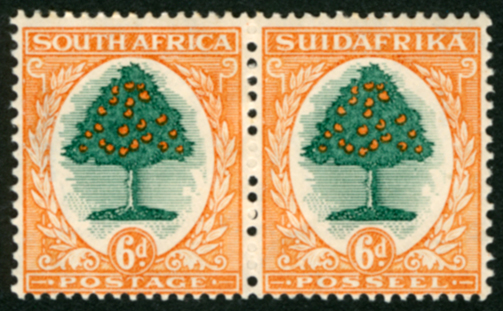
1926 1 May. London Pictorial Definitive green and orange 6d Orange Tree..

1938 14 December. Voortrekker Centenary Memorial Fund Surcharge.
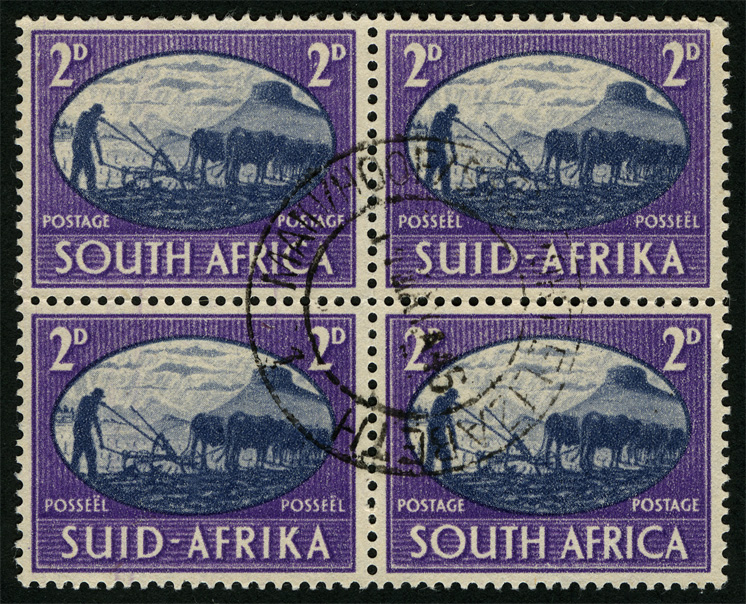
1945 3 December. Victory Issue.
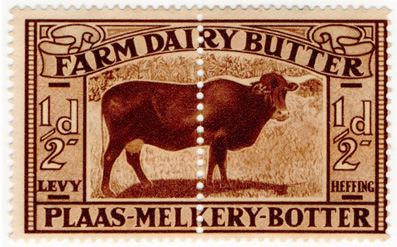
1930. Union of South Africa Farm Dairy Butter Revenue.
½d red-brown mint pair (second more detailed print). Barefoot No.1.
I am disappointed. I expected more patriotic stamps extolling the virtues of farming from the governments of Botha, Smuts and Hertzog. In the next post I will look at the stamps of the formal Apartheid years, 1948 - 1994, especially those of the Republic era. I expect to find many more stamps celebrating farming and a love of the land. I remember my Christian National education and my Belgian Afrikaans language teacher telling me I was stupid to think that growing up in a city was a better than on a farm. Well, it was the Sixties and I was a 'soutie', uncomfortable in my too tightly tapered jeans, one foot in town and my holidays in the country! Or something of the sort!
Quote from Steve on August 12, 2025, 12:07 pmFrench Huguenots - Franschhoek
The postcards below were previously B/W. I have colourised them with AI. The program I used was ChatGPT. There is nothing difficult in doing this. It is Easy Peasy. Done in Flash with Harold Wilson's 'White Heat of Technology'. See the 'How To' in the Technology thread.
The Huguenot Memorial Monument in Franschhoek, Western Cape, South Africa, is dedicated to the cultural influences that Huguenots have brought to the Cape Colony (and ultimately the whole of South Africa) after their immigration during the 17th and 18th centuries to escape violent religous persecution in Roman Catholic France. They came as refugees looking to take advantage of commercial opportunities offered to them by the VOC, specifically in the area of wine-making.
The Huguenots began to arrive in the Dutch Cape Colony from about 1688 to 1689. They settled mainly outside of Cape Town in rural areas close to the Drakenstein mountain. This area was generally referred to as the 'Hottentot's Holland' in the earliest years of the VOC at the Cape, a reference to the Khoi's occupation of the area. Over time the main valley of the Huguenots habitation became known as 'Franschhoek ', (Dutch. the French corner).
Circa 1950. B/W Real Photo postcard '0124 Fransch Hoek. CP.' colourised with AI (ChatGPT. 12/08/2025).
Original Photo by 'Somerset Studios, Somerset West. CP.' COPYRIGHT PHOTOGRAPH.Their advanced viticulture and winemaking skills made a significant contribution to the Cape’s nascent wine industry. In addition, their agricultural expertise improved farming methods, contributing to wheat, fruit, and vegetable cultivation. The Huguenots also influenced local culture, language, and architecture. Over time they assimilated into the Dutch-speaking settler community. (I was told once that the last time a Huguenot spoke French in the valley was in the late 1920s.) Their legacy remains visible in a multitude of Afrikaans surnames, (like Botha, De Wet, De Villiers, Du Plessis, Du Toit, Joubert, Nel, Marais, etc,.). Some names were assimilated into Dutch / Afrikaans. (Leclerc became De Klerk, Villon beca Viljoen, Rétif became Retief, etc', and in my family's case, Neel became Nel.)
Circa 1950. B/W Real Photo postcard '0126 Huguenot Memorial, Fransch Hoek. CP.' colourised with AI (ChatGPT. 12/08/2025).
Original Photo by 'Somerset Studios, Somerset West. CP.' COPYRIGHT PHOTOGRAPH.The Huguenot Memorial Monumentt was designed by J.C. Jongens, completed in 1945, and inaugurated by Dr. A.J. van der Merwe on 17 April 1948. The three high arches symbolize the Holy Trinity: the Father, Son and Holy Spirit. On top of the arches is the sun of righteousness and above that, the Huguenot cross of their Christian faith.
1939. 17 July. 250th Anniversary of the Huguenot Landing in SA.
Surcharged for Huguenot Commemorative Fund. (See above PC for where the money went!)
French Huguenots - Franschhoek
The postcards below were previously B/W. I have colourised them with AI. The program I used was ChatGPT. There is nothing difficult in doing this. It is Easy Peasy. Done in Flash with Harold Wilson's 'White Heat of Technology'. See the 'How To' in the Technology thread.
The Huguenot Memorial Monument in Franschhoek, Western Cape, South Africa, is dedicated to the cultural influences that Huguenots have brought to the Cape Colony (and ultimately the whole of South Africa) after their immigration during the 17th and 18th centuries to escape violent religous persecution in Roman Catholic France. They came as refugees looking to take advantage of commercial opportunities offered to them by the VOC, specifically in the area of wine-making.
The Huguenots began to arrive in the Dutch Cape Colony from about 1688 to 1689. They settled mainly outside of Cape Town in rural areas close to the Drakenstein mountain. This area was generally referred to as the 'Hottentot's Holland' in the earliest years of the VOC at the Cape, a reference to the Khoi's occupation of the area. Over time the main valley of the Huguenots habitation became known as 'Franschhoek ', (Dutch. the French corner).
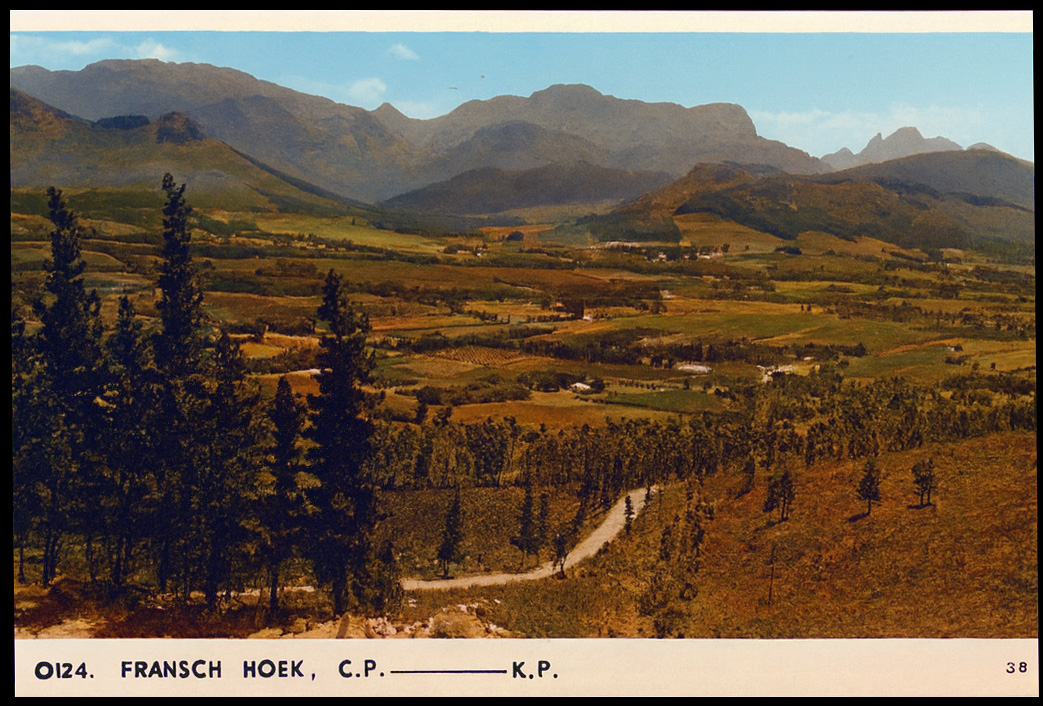
Circa 1950. B/W Real Photo postcard '0124 Fransch Hoek. CP.' colourised with AI (ChatGPT. 12/08/2025).
Original Photo by 'Somerset Studios, Somerset West. CP.' COPYRIGHT PHOTOGRAPH.
Their advanced viticulture and winemaking skills made a significant contribution to the Cape’s nascent wine industry. In addition, their agricultural expertise improved farming methods, contributing to wheat, fruit, and vegetable cultivation. The Huguenots also influenced local culture, language, and architecture. Over time they assimilated into the Dutch-speaking settler community. (I was told once that the last time a Huguenot spoke French in the valley was in the late 1920s.) Their legacy remains visible in a multitude of Afrikaans surnames, (like Botha, De Wet, De Villiers, Du Plessis, Du Toit, Joubert, Nel, Marais, etc,.). Some names were assimilated into Dutch / Afrikaans. (Leclerc became De Klerk, Villon beca Viljoen, Rétif became Retief, etc', and in my family's case, Neel became Nel.)
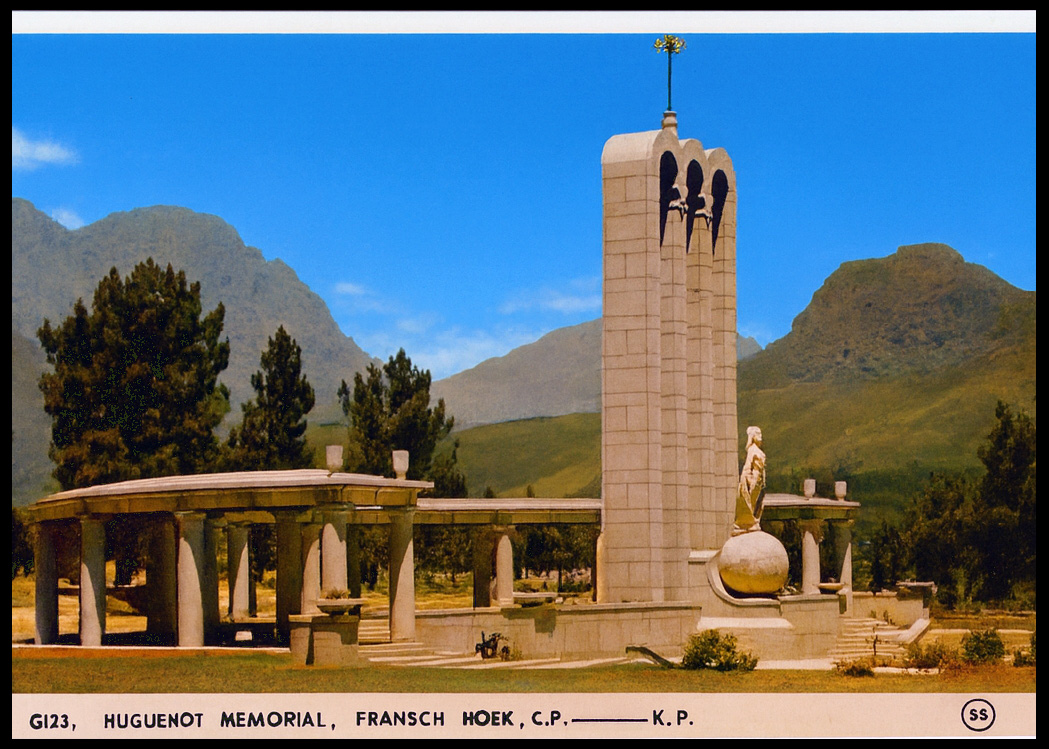
Circa 1950. B/W Real Photo postcard '0126 Huguenot Memorial, Fransch Hoek. CP.' colourised with AI (ChatGPT. 12/08/2025).
Original Photo by 'Somerset Studios, Somerset West. CP.' COPYRIGHT PHOTOGRAPH.
The Huguenot Memorial Monumentt was designed by J.C. Jongens, completed in 1945, and inaugurated by Dr. A.J. van der Merwe on 17 April 1948. The three high arches symbolize the Holy Trinity: the Father, Son and Holy Spirit. On top of the arches is the sun of righteousness and above that, the Huguenot cross of their Christian faith.
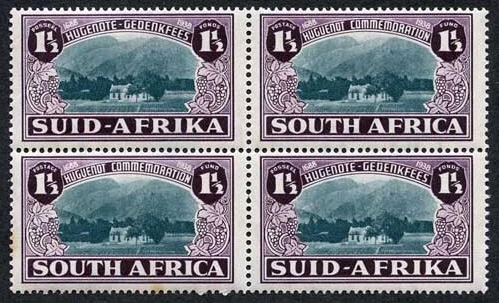
1939. 17 July. 250th Anniversary of the Huguenot Landing in SA.
Surcharged for Huguenot Commemorative Fund. (See above PC for where the money went!)
